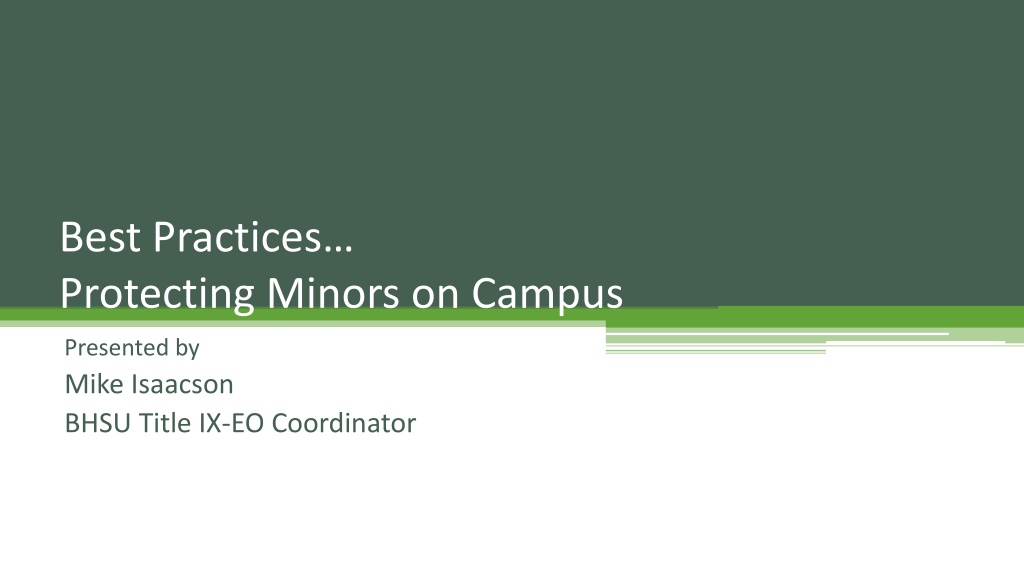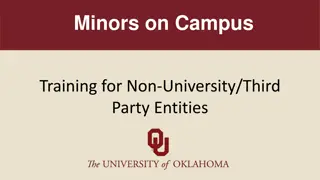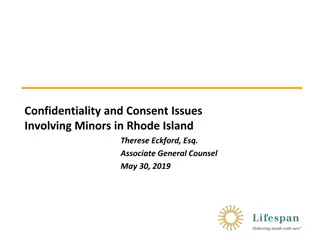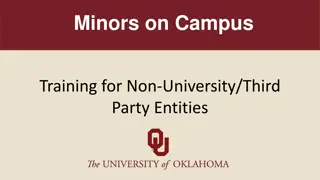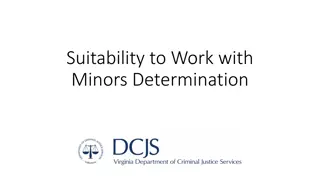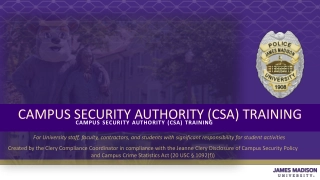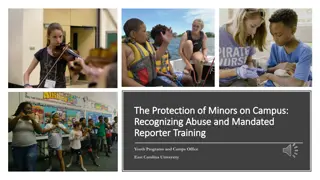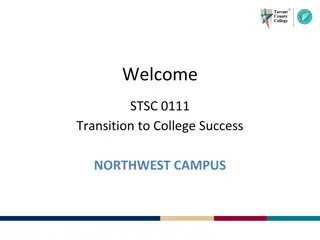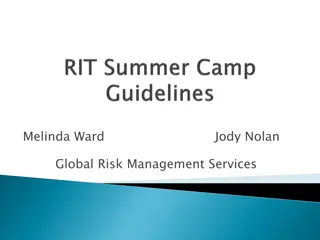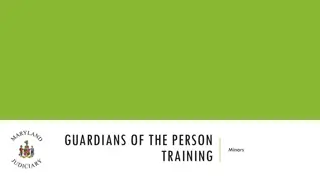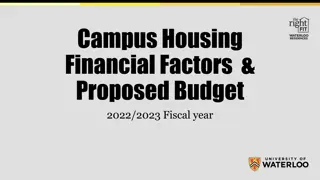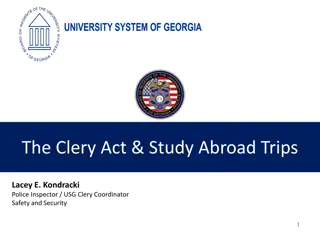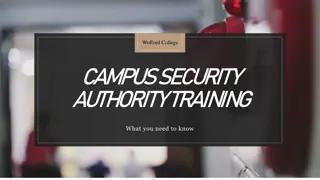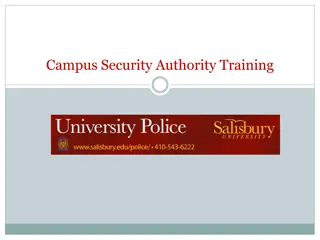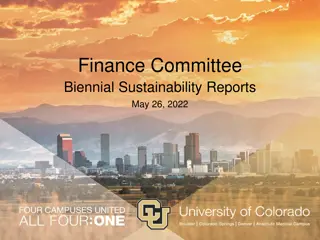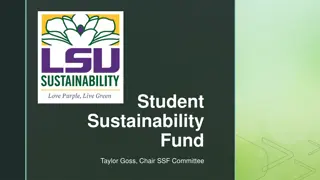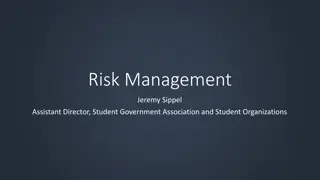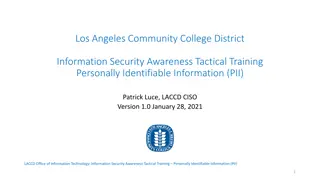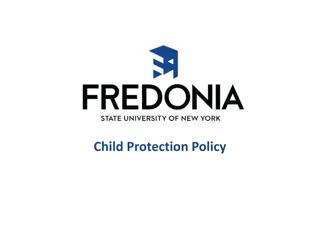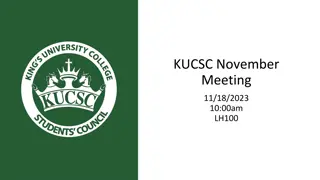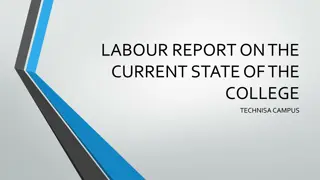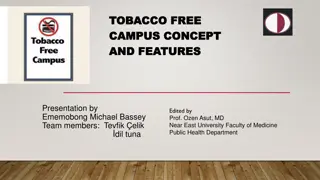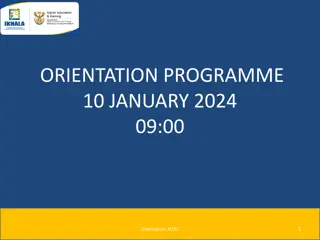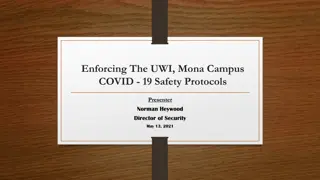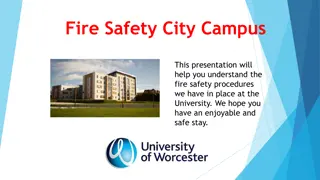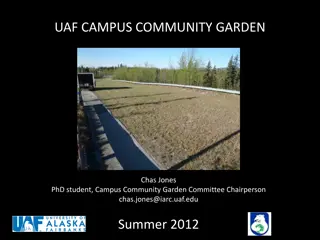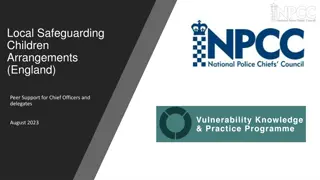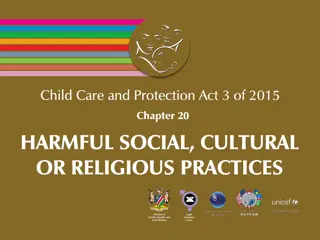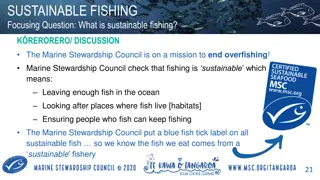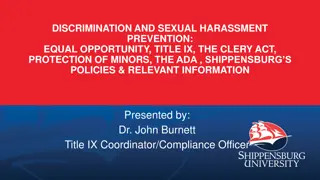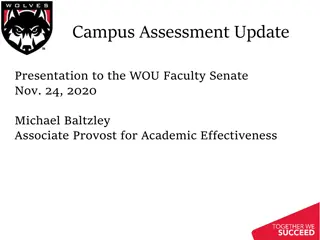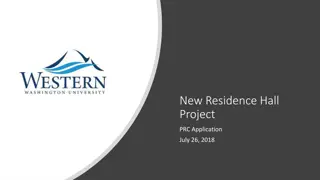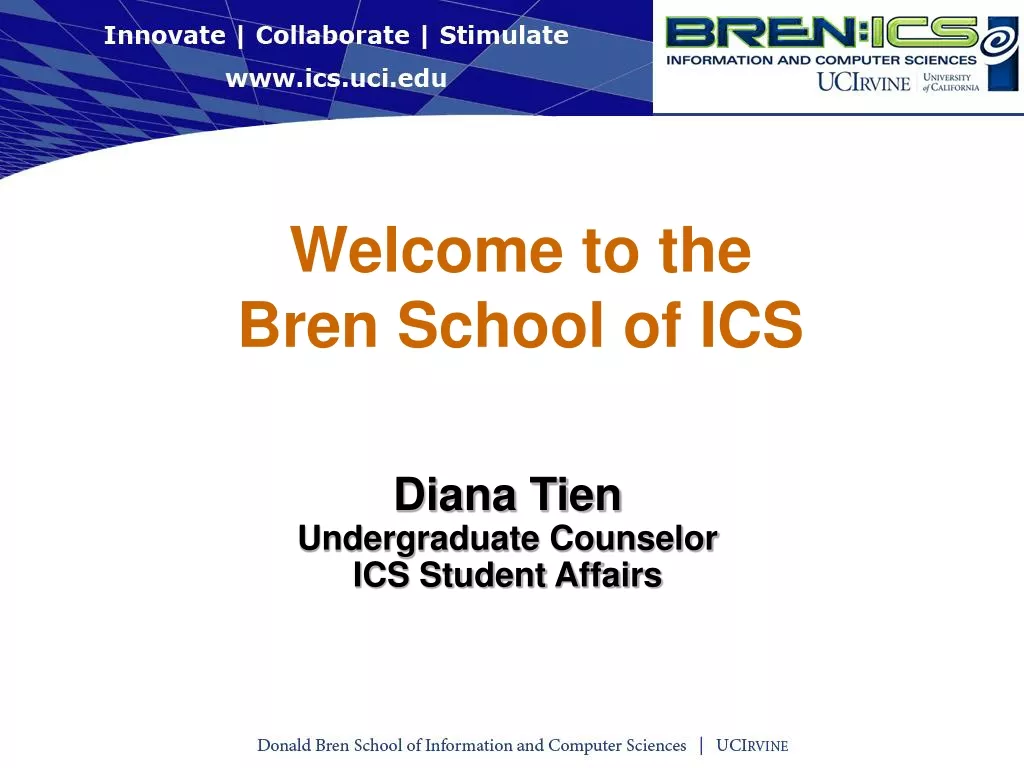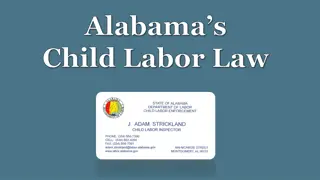Best Practices for Protecting Minors on Campus
Understanding and addressing sexual discrimination, harassment, and misconduct against minors on campus is crucial, especially in the context of Title IX regulations. This content highlights the responsibilities of educational institutions, the definition of sexual harassment, the importance of preventing and responding to allegations effectively, and the impact of incidents like the Jerry Sandusky scandal on campus policies and practices relating to minors. Emphasizing the need for proactive measures and revisiting existing protocols, the content provides guidance on creating a safe environment for minors in educational settings.
Download Presentation

Please find below an Image/Link to download the presentation.
The content on the website is provided AS IS for your information and personal use only. It may not be sold, licensed, or shared on other websites without obtaining consent from the author. Download presentation by click this link. If you encounter any issues during the download, it is possible that the publisher has removed the file from their server.
E N D
Presentation Transcript
Best Practices Protecting Minors on Campus Presented by Mike Isaacson BHSU Title IX-EO Coordinator
Complaints Under Title IX BHSU is required to address sexual discrimination/harassment, which includes gender-based and sexual misconduct against students, faculty, and staff whether perpetrated by peers or by employees of the institution. The Title IX Coordinator is responsible for responding to all forms of gender-based and sexual misconduct. BHSU employees having knowledge of sexual discrimination/harassment are required to notify the Title IX Coordinator.
Minors on Campus: Understanding Our Title IX Responsibilities
Sexual Harassment Both the Department of Education and the United States Supreme Court have found that sexual harassment is a form of sexual discrimination prohibited by Title IX. Sexual harassment is defined as "unwelcome conduct of a sexual nature that may include "unwelcome sexual advances, requests for sexual favors, and other verbal, nonverbal, or physical conduct of a sexual nature. Sexual harassment also encompasses nonsexual conduct, provided the behavior is unwelcome, is based on sex or sexual stereotyping, and has the effect of interfering with a student s ability to participate in or benefit from a school program, such as participation in athletics.
Sexual Harassment continued Title IX, the federal statute prohibiting discrimination on the basis of sex at educational institutions receiving federal funds, requires an institution to take steps toward effectively preventing and responding to allegations of sexual harassment. This includes misconduct against minors on campus whether perpetrated by employees, volunteers, contractors, or students. Individuals under the age of eighteen have always been present on campus in various capacities, including as enrolled students, prospective students, summer camp attendees, athletic recruits, visitors and enrollees in on- campus child-care facilities. With the growth of College Dual-Credit programs, it is expected that the presence of minors on campus will further increase in the coming years.
Sexual Harassment the Jerry Sandusky scandal In the aftermath of the Jerry Sandusky scandal in 2011, many campuses began to examine their policies and practices regarding minors on campus. Like this situation, programs involving minors are often run by multiple departments that may or may not be treating similar situations in a comparable and protective manner. In light of increased attention on sexual assault issues and their complexities, it may be time to revisit your policies and practices that address minors on campus. Where do we start? Right here with these 5 guiding principle
#1 Train Summer Staff and Student Hosts Train seasonal staff and student hosts on how to handle harassment, discrimination, sexual assaults, accidents and injuries. Are individuals aware of proper precautions to take when working with minors, such as never being alone with a minor, not communicating with minors outside of the program (i.e. through social media or texting) and maintaining professional boundaries when dealing with minors? When your organization is running the program, this training is critical, particularly when trained staff members may not be as readily available on an evening or weekend or during breaks.
#2 Understand the High Risk Nature of Residential Camps Overnight programs serving minors are considered high risk due to vulnerabilities in behind closed door activities, dressing/undressing situations, and limits on supervision. Any BHSU program that conducts overnight operations should include at minimum, the following: Prohibition on program staff spending the night one on one with a minor. Prohibition on program staff/students changing clothes while the other is present. Smaller program personnel to staff ratios and unscheduled bed checks on minors. Strict curfews and procedures if a minor is not accounted for at curfew or at a bed check.
#2 coninuted Orientation to students on where/how to locate staff and emergency exit plans. Communication to students on reporting any activity that occurs on an overnight that is in violation of policy or makes him/her uncomfortable. A facility check to include security, locks, and no access points for non- participants; limits and monitoring of restricted areas in the facility the overnight is being conducted. If the overnight is in a publically accessible area, procedures that address safety and risk must be in place.
#3 Informed Participants are Safer Participants Training your staff is not enough; you must also train participants. Make sure participants in programs for minors understand the rules of conduct and know how to report misconduct. Orient students on how to be safe on campus, including how to avoid crimes, what to do in an emergency, how to contact security and any other safety rules that may be helpful while participating in the program.
#4 Kids will be Kids No matter how much training you provide minor participants, their inexperience, curiosity, and sense of invincibility may get them into unexpected situations. Provide proper supervision, particularly in residential settings, and set curfews when appropriate to help protect participants.
#5 When in Doubt, Report The law requires that certain misconduct must be reported. South Dakotans have a legal obligation to report felonies to law enforcement. Additionally, all BHSU employees have a mandatory duty to report. Responsible Employees must immediately report harassment and discrimination to the Title IX Coordinator.
Best Practices Protecting Minors on Campus
Introduction The purpose of this training is to protect minors (any person under the age of 18) on Black Hills State University s premises or those involved in University sponsored programs by providing guidance on Title IX Best Practices and reporting requirements for minors on campus.
Who Must Comply? Best Practices for minors on campus at BHSU affects all units of the university, such as athletic camps, academic camps, and other programs, and similar activities intended for minors. Specifically, Best Practices apply to all adults who: Interact with children or work in programs that take place on university land or facilities Work under the authority and direction of BHSU Work as BHSU employees and who interact with or employ minors. For the purposes of the training and this document, adults who interact with minors as part of an activity or program are referred to as program staff member.
Training Objectives After completing this training, you will be able to: Protect minors who participate in activities and programs Understand what constitutes sexual harassment Act as a positive role model and avoid putting yourself in a risky situation
The Facts about Sexual Abuse Most people consider child sexual abuse to be unacceptable behavior. At the same time, one in four girls and one in six boys experience sexual abuse before their eighteenth birthday. Therefore, we have to assume that child sexual abuse is happening to both boys and girls in our community today. Sexual abuse thrives in an environment where adults are inattentive, in denial, or afraid to take action. We must actively work to prevent it. We must take steps to create a safe environment for children. The earlier that abuse is caught, the better the chance of recovery for the child.
What is Sexual Abuse? Sexual abuse is any sexual act between an adult and a child or between two children when one exerts power over the other. There can be no case of a consensual act between an adult and a child due to the inherent power dynamic. Forcing, coercing, or persuading a child to engage in any type of sexual contact is sexual abuse. Sexual abuse doesn t always involve bodily contact. If an adult engages in any sexual behavior with a child to meet the adult s sexual interest or needs, it is sexual abuse. Exhibitionism, exposure to pornography, voyeurism, sexting, and other communication in a sexual manner over the phone or internet is sexual abuse. Sexual abuse can occur between members of the opposite sex or members of the same sex. Sexual abuse is a crime. Aiding and abetting a sexual offender is also a crime.
What is Sexual Harassment? Sexual harassment is unwelcome verbal or physical sexual conduct which because of its severity and/or persistence interferes significantly with an individual s work or education, or adversely affects an individual s living conditions. Harassment also occurs when a person uses a position of authority to engage in unwelcome sexual advances, requests for sexual favors, or other verbal or physical conduct of a sexual nature. Sexual harassment is a form of sexual abuse.
Portrait of an Abuser A myth of sexual abuse is that the abusers are usually strangers. On the contrary, most child sexual abusers are known to the victim. The abuser could be a family member, friend of the family, teacher, older youth, or coach. In addition, one third of all child sexual abuse is committed by another child under the age of eighteen.
Adequate Supervision of Children All programs and units must provide for the appropriate supervision of visiting children at BHSU. Below are some Best Practices that must be considered.
General Behavior Expectations As a program staff member, you must avoid behaviors that could cause harm or be misinterpreted. Do not engage in any sexual activity with children. Do not make sexual comments or tell sexual jokes to children. Do not share sexually explicit material with children (or assist in any way to provide access to such material). Do not shower, bathe, or undress with or in the presence of a Minor.
Your Home Do not invite individual children to your home. Any exceptions require authorization by the program director and written authorization by a parent or guardian.
Meetings Most sexual abuse incidents happen in one adult and one child situations. If you eliminate one adult and one child situations, you reduce the risk of abuse. Do not be alone with a single child. Do not meet with children outside of established times for Program activities. If one-on-one interaction is required, meet in open, well illuminated spaces or rooms with windows observable by other adults from the program, unless the one-on-one interaction is expressly authorized by the program director, dean, department chairperson.
Communications Do not engage or allow minors to engage you in romantic or sexual conversations or related matters. Do not engage or communicate with minors through email, text messages, social networking websites, internet chat rooms, or other forms of social media at any time except and unless there is an educational or programmatic purpose and the content of the communication is consistent with the mission of the program and the university. Be aware of the impact of your words and language on Minors. Do not tell children this is just between the two of us or use similar language that encourages Minors to keep secrets from their parent/guardians.
Touching Touching should generally only be in the open and in response to the child s needs, for a purpose that is consistent with the Program s mission and culture, and/or for a clear educational, developmental, or health related purpose, such as the treatment of an injury. Many children are taught that it is not okay to touch any part that covers where the child wears a bathing suit. These are the private areas. If you must touch a child, ask if it is okay to touch first. Children have the permission and power to say No to any unwanted or uncomfortable touch. Any resistance from the minor should be respected. If restraint is necessary to protect a child or other children from harm, all incidents must be documented and disclosed to the program director and the minor s parent or guardian.
Touching continued Do not touch children in a manner that a reasonable person could interpret as inappropriate. Do not engage in any abusive conduct of any kind toward, or in the presence of, a child including but not limited to verbal abuse, striking, hitting, punching, poking, spanking, or restraining. Do not touch Minors in a manner that a reasonable person could interpret as inappropriate.
Alcohol and Drugs Do not use, possess or be under the influence of alcohol or illegal drugs while on duty or when responsible for a child s welfare.
Transportation When transporting children in a program, more than one adult from the program must be present in the vehicle, except when multiple children will be in the vehicle at all times through the transportation. Avoid using personal vehicles, if possible. .
Failure to Comply Failure to comply with these Best Practices may lead to disciplinary action and/or revocation of the opportunity to use university facilities and land. Therefore, the entire program or activity may be restricted based on the actions of a single program staff member. In addition, if you are accused of sexual abuse of a child, you will be subject to the appropriate investigations and actions by the criminal justice and social services systems. These actions are separate and apart from the university policy and process. .
Reporting Potential Abuse Remember that child sexual abuse thrives in an environment where adults are inattentive, in denial, or afraid to take action. We must actively work to prevent it. We must actively work to create a safe environment for children. The earlier that abuse is caught, the better the chance of recovery for the child.
Duty to Report All University employees have a duty to report any suspected neglect or abuse of a minor. You do not have to witness the abuse to report it. It is not your responsibility to verify whether a report or suspicion is truly abuse. You are simply responsible for reporting the situation. Notify the Title IX Coordinator or designee as well as the Program Director. If, however, the Program Director may be involved in the suspected assault or abuse, only report the suspected assault or abuse directly to the Title IX Coordinator or designee. Inform the Campus Safety and Security or other appropriate law enforcement agency, and if the suspected assault or abuse presents an imminent danger to a Minor, contact should occur immediately.
Your Responsibility If you suspect abuse or you suspect someone is grooming a child for abuse, you must trust your gut feeling and report it. If you are correct, you have made a difference in a child s life. If you see something, say something. You may be concerned that you are making a mistake. However, you are protected for reporting a suspicion. Program staff members making a report in good faith will be protected from criminal and civil liability for making the report.
